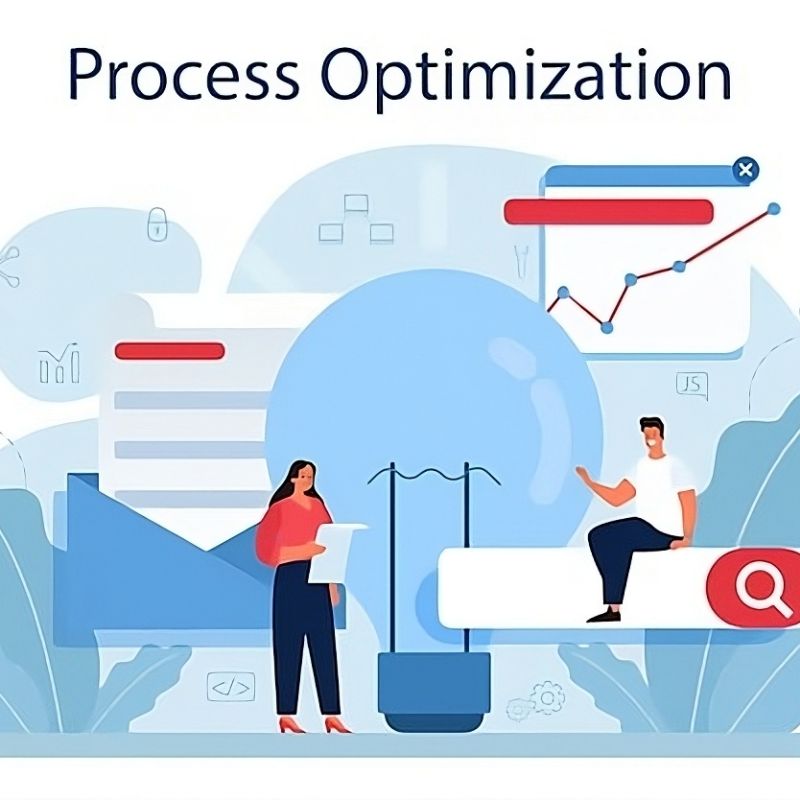May,2025
Business Process Optimization Guide: Tools and Examples
Category: Business Process Management

In the fast-paced world of healthcare, where every second counts, business process optimization is a critical tool for improving operational efficiency and ensuring the best patient care. Whereas, business process optimization services involve streamlining and improving existing processes within a business to enhance efficiency, productivity, and overall effectiveness
Healthcare providers and revenue cycle professionals must constantly look for ways to streamline their processes to improve service delivery and enhance profitability. Optimizing business processes is not just about cutting costs.
It’s about refining workflows, reducing errors, and increasing overall effectiveness.
In this guide, you will explore how to optimize work processes, what business process optimization entails, and how healthcare organizations can leverage tools to achieve better outcomes.
What Is Business Process Optimization?
At its core, business process optimization refers to the systematic improvement of processes within an organization. The goal is to make these processes as efficient, cost-effective, and impactful as possible. In healthcare, this means refining patient intake, billing, coding, and claims processing systems to ensure that the revenue cycle flows smoothly without interruptions or inefficiencies.
The main aim of process optimization in healthcare is to minimize the time spent on non-value-added activities, reduce the risk of errors, and ensure compliance with regulatory standards like HIPAA, Medicare, and Medicaid. By doing so, healthcare providers can allocate more resources to patient care, reduce operational costs, and improve overall patient satisfaction.
The Role of Revenue Codes in the Revenue Cycle
One often-overlooked aspect of business process optimization is the role of revenue codes in the revenue cycle. Revenue codes are numeric codes used in medical billing and coding to identify services, procedures, and the location where services were provided.
These codes play a crucial role in ensuring that claims are processed accurately and promptly. Incorrectly applying revenue codes can result in delays, rejections, or underpayments.
For example, if a hospital uses the wrong revenue code when billing for a surgical procedure, the payer may deny the claim, causing unnecessary delays in payment. This error can disrupt the revenue cycle, resulting in increased administrative costs and a backlog of unprocessed claims.
By optimizing business processes, healthcare providers can reduce the likelihood of such errors, ensuring that revenue codes are accurately applied, leading to faster and more reliable reimbursements.
Best Practices for Business Process Optimization in Healthcare
Optimizing processes in healthcare is a multifaceted endeavor that requires careful planning and the right tools. Here are some best practices to guide healthcare organizations through this critical task:
1. Map Out Your Existing Processes
Before any optimization can occur, it’s important to understand the existing processes. Map out each step in the revenue cycle, from patient intake and coding to billing and payment collection. This will allow you to identify bottlenecks, redundancies, and inefficiencies that are slowing down your operations.
For instance, if there are frequent delays in the coding process, it could be a sign that your coders are struggling to find the correct codes or that your coding system is outdated. Once you’ve mapped out your processes, you’ll be in a better position to identify which areas need attention and how to optimize processes.
2. Leverage Business Process Optimization Tools
There are numerous business process optimization tools available today that can help automate, streamline, and improve healthcare workflows. Here is the list of business process optimization tools:
| S. No | Tool Name | Category | Features |
| 1 | Cerner | EHR System | Electronic health records, patient management, and reporting. |
| 2 | Epic Systems | EHR System | Comprehensive EHR, practice management, and clinical decision support. |
| 3 | Meditech | EHR System | Integrated EHR, scheduling, and clinical workflow optimization. |
| 4 | Allscripts | EHR System | EHR, patient management, billing, and patient engagement. |
| 5 | Athenahealth | EHR System | Cloud-based EHR, medical billing, and patient portal. |
| 6 | NextGen Healthcare | EHR System | EHR, telemedicine, patient engagement, revenue cycle management. |
| 7 | Kareo | Practice Management | Practice management, billing, appointment scheduling, and reporting. |
| 8 | eClinicalWorks | EHR System | Comprehensive EHR, patient engagement, population health management. |
These tools can be particularly useful in areas like medical billing, coding, and claims management. For example:
- Robotic Process Automation (RPA): RPA can automate repetitive tasks like data entry, claims submission, and denial management. By using RPA tools, healthcare organizations can reduce administrative burdens, free up staff to focus on higher-level tasks, and increase accuracy in billing and coding.
- Electronic Health Records (EHR) Systems: Modern EHR systems can improve the efficiency of patient data management, billing, and coding by reducing the need for manual entry and improving accuracy. By integrating billing and coding directly into the EHR system, providers can minimize the risk of errors and speed up the claims process.
- Revenue Cycle Management (RCM) Software: RCM software can help track the entire revenue cycle, from patient registration to payment collection. These tools allow providers to monitor key metrics like claim denials, underpayments, and patient balances, providing valuable insights into areas that need improvement.
3. Train Your Staff Regularly
No matter how advanced your tools are, your staff plays a pivotal role in optimizing processes. Ensuring that your team members are properly trained on the latest billing and coding practices, revenue cycle management software, and compliance requirements is essential. Regular training sessions can help reduce errors in medical coding, improve the efficiency of your billing team, and keep everyone up to date on changes in regulations or payer requirements.
4. Standardize Processes
Standardizing processes across your organization is another important step in process optimization. By creating clear workflows and guidelines, you can ensure consistency across teams. For example, if different departments within your healthcare facility follow different procedures for submitting claims, it can lead to confusion and delays. Standardizing procedures will help ensure that everyone follows the same process, improving the speed and accuracy of claims submission.
5. Monitor and Measure Performance
After implementing optimization strategies, it’s important to track your progress. Use key performance indicators (KPIs) to monitor how well your processes are performing. Metrics like claim rejection rates, the time it takes to process claims, and the accuracy of coding can give you a clear picture of whether your optimization efforts are working.
Additionally, gather feedback from your staff about their experience with the new tools or processes. Are they able to work more efficiently? Are there any issues that need addressing? Regularly measuring performance ensures that your optimization efforts are successful and sustainable.
Process Optimization Examples in Healthcare

To further illustrate the benefits of process optimization, let’s look at some real-life examples from healthcare organizations:
- Optimizing Patient Scheduling: A large hospital network was facing long patient wait times due to inefficient scheduling processes. By implementing an automated scheduling system that integrated with their EHR, they were able to optimize appointment bookings, reduce scheduling errors, and improve patient flow. As a result, the hospital saw a 15% increase in patient throughput and a 20% reduction in missed appointments.
- Optimizing Medical Billing and Coding: A medical practice was struggling with high claim rejection rates due to coding errors. By implementing coding software that integrated with their EHR and providing ongoing training for their coding team, they reduced coding errors by 30%. This not only decreased claim denials but also accelerated reimbursement cycles, improving cash flow for the practice.
- Streamlining Revenue Cycle Management: A healthcare provider struggled with delayed reimbursements due to inefficient revenue cycle management services. After implementing an RCM platform that automated claim submissions, denials management, and payment posting, they were able to speed up the billing process and improve collections. This resulted in a 25% reduction in accounts receivable days and a 15% increase in revenue.
Compliance Considerations in Business Process Optimization
While business process optimization can bring significant benefits, it’s important to ensure that your optimization efforts align with healthcare regulations and compliance requirements. For example:
- HIPAA Compliance: Any optimization tools or processes that involve patient data must comply with HIPAA regulations. Ensure that your EHR systems, billing software, and automation tools are all secure and follow best practices for safeguarding patient information.
- Medicare and Medicaid Regulations: When optimizing the billing and coding process, make sure your processes adhere to the specific guidelines for Medicare and Medicaid billing. Misapplication of codes or improper billing can lead to penalties or reimbursement delays.
- Audits and Reporting: Regular audits are essential for maintaining compliance and ensuring that your process optimization efforts are effective. Many healthcare organizations leverage automated audit tools to track coding accuracy, billing integrity, and payer requirements.
Conclusion
Business process optimization is a critical strategy for healthcare providers aiming to improve efficiency, reduce errors, and enhance the patient experience. By leveraging the right tools, streamlining workflows, and continuously monitoring performance, healthcare organizations can optimize their revenue cycle, improve cash flow, and provide better care.
At AffinityCore, we specialize in medical billing and coding services that help healthcare providers streamline their revenue cycles. Our team works with you to identify inefficiencies, implement effective processes, and ensure compliance with all relevant regulations.
Contact us today to learn how we can help you optimize your business processes and improve your bottom line.
Frequently Asked Questions
What is an example of business optimization?
An example of business optimization is streamlining operations by using automation tools to improve efficiency, reduce costs, and enhance productivity. For instance, implementing software like CRM systems or workflow automation platforms can optimize customer interactions, inventory management, and internal processes.
What are the steps of process optimization?
The steps of process optimization include:
-
Identify goals: Define clear objectives to improve efficiency and reduce costs.
-
Analyze current processes: Evaluate existing workflows to identify bottlenecks and inefficiencies.
-
Redesign processes: Streamline and implement improvements to enhance performance.
-
Implement changes: Introduce new tools or technologies to optimize workflows.
-
Monitor results: Measure performance and adjust as needed for continuous improvement.
What is an example of an optimization process?
An example of an optimization process includes:
-
Eliminating redundancies: Removing unnecessary steps or tasks to improve efficiency.
-
Streamlining workflows: Simplifying processes to reduce delays and improve productivity.
-
Improving communication: Enhancing how teams exchange information to prevent misunderstandings and delays.
-
Forecasting changes: Anticipating future needs or trends to stay ahead of market demands.
These steps help businesses enhance their overall efficiency and performance.

